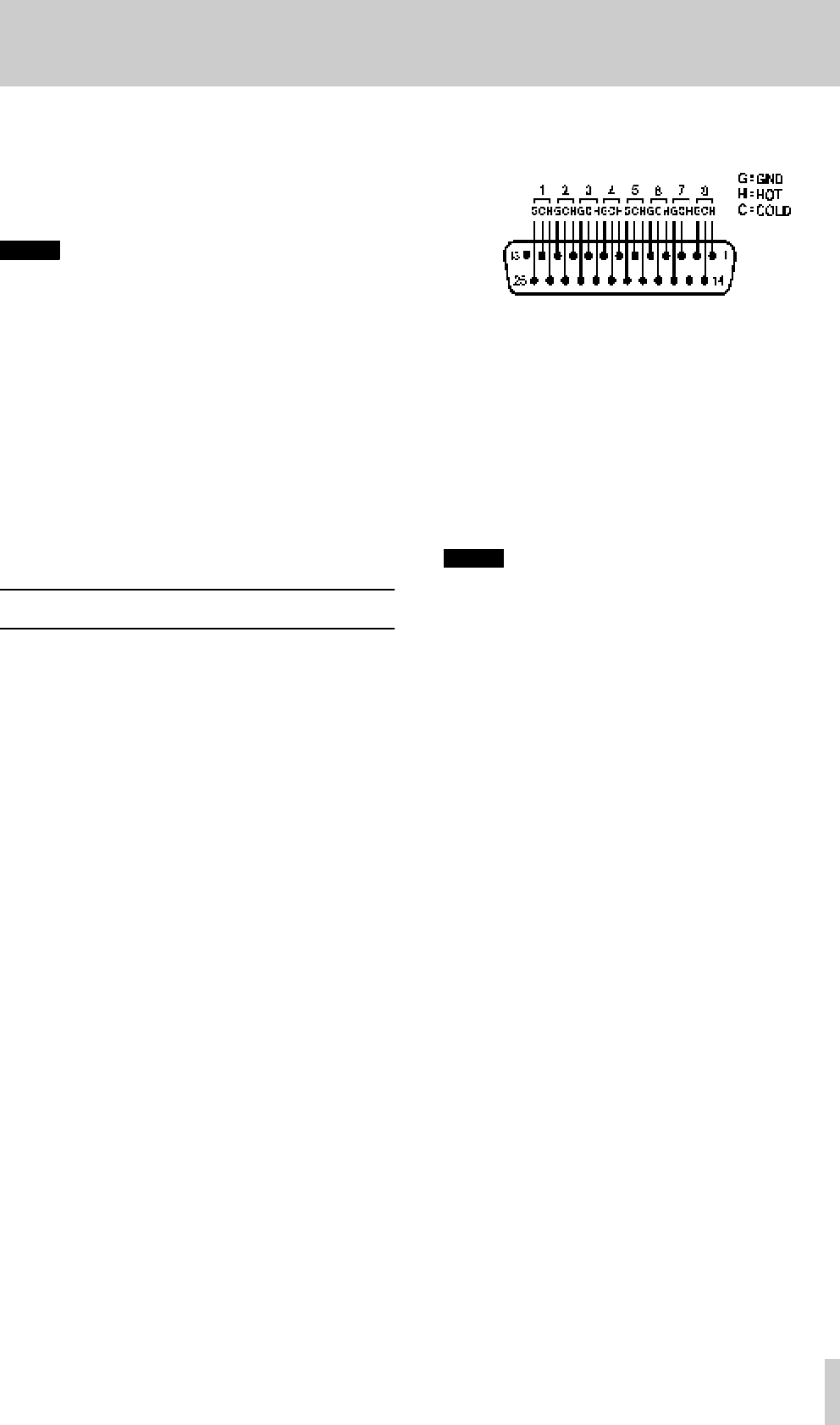
TASCAM DA-78HR
17
3 - Connections
This section explains how to connect other equip-
ment to the DA-78HR. It is not intended as a com-
plete reference to the use of the DA-78HR. See the
appropriate sections for full details of how these con-
nectors are used.
NOTE
S—IMPORTANT
When making connections between the DA-78HR and
other equipment, whether audio or control, both the DA-
78HR and the other equipment must be turned
off
, other-
wise damage may be caused to the DA-78HR and/or the
other equipment.
Only use TASCAM-supplied and TASCAM-approved
cables when making connections to the DA-78HR. Though
the cables and connectors may resemble computer cables,
they serve different purposes, and meet a different set of
specifications. The use of cables other than TASCAM
cables will at best cause the equipment to work erratically,
and at worst cause damage to the equipment.
If the use of cables other than TASCAM cables
causes or results in damage, the warranty is voided.
3.1 Audio connections
Other audio equipment can be connected to the DA-
78HR either using analog or digital interfaces.
Selection for the input source (analog or digital) on a
global or individual track basis is made from the
menus. See 5.3, “Input selection” for details.
3.1.1 Balanced analog audio
connections
All balanced analog input and output audio connec-
tions to the DA-78HR are made through 25-pin D-
sub connectors.
All these audio inputs and outputs are balanced and
are rated at a nominal +4dBu level.
This allows convenient and tidy cabling between the
DA-78HR and other units such as the TASCAM M-
1600 series of mixing consoles.
It is not recommended that you make up your own
cables—consult your TASCAM dealer for availabil-
ity of suitable ready-made cables (and see 12.1.8,
“Cables”). However, we recognize that every situa-
tion has its own unique features, and there are occa-
sions when a special cable must be made.
Before starting to make the cable, we suggest you
contact your TASCAM dealer for full details of cable
specifications, etc.
The pinouts for both the
ANALOG OUTPUT
and
IN PU T
connectors are as follows:
where
G
=ground,
H
=”hot” (+) and
C
=”cold” (–).
The impedance of the inputs is 20kΩ and that of the
outputs is 10Ω.
3.1. 2 Unbal anced anal og audio
connections
In addition to the balanced analog set of connections,
there are eight RCA jacks for input signals and eight
for output. These are, of course, unbalanced, and the
nominal signal level is –10 dBV.
NOTE
Only connect and use one set of analog inputs at a
time. There is no facility to switch between the two
sets of analog input connectors.
3.1.3 Digital audio connections
Multitrack digital audio input and output signals are
carried on a single 25-pin D-sub connector. The sig-
nals are in TDIF-1 format.
To carry signals between a DA-78HR and another
unit equipped with TDIF-1 interfaces, such as the
TASCAM series of digital mixing consoles or other
DTRS recorders, use a PW-88D cable (1 meter long)
or a PW-88DL cable (5 meters long).
If you need to connect the DA-78HR to a digital
audio source using a different format, we recommend
the use of the following units:
• TASCAM IF-88AE Interface Unit—converts
between the TDIF-1 and AES/EBU formats
(8 channels). It also provides SPDIF format
conversion facilities.
• TASCAM IF-AE8—also provides sophisti-
cated conversion facilities between the TDIF-
1 and AES/EBU data formats.
• TASCAM IF-88SD Interface Unit—converts
between the TDIF-1 and SDIF-2 digital audio
formats.
• The TASCAM IF-TAD—converts between
the TDIF-1 and ADAT data formats, using a
digital optical input/output for the ADAT data.


















